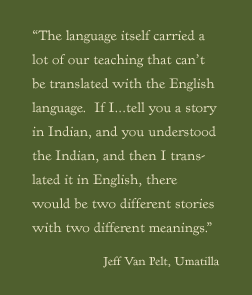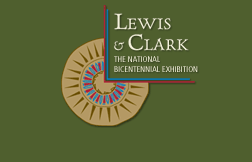

|
 |



Lesson Plan 4: New Languages
OBJECTIVES
Students will:
- learn that "new languages" form
- define a "jargon" language
- learn that language formation/creation is a continual process going on today
MATERIALS
OPENING
Why do new languages form? Can you think of specific reasons why a new language might be created? (a major reason is that two people groups who speak different languages find themselves needing to communicate over a long period of time)
PROCEDURE
- Provide some background related to Lewis and Clark.
When Lewis and Clark and the expedition descended the Columbia River toward the Pacific Ocean they were hoping to find American or British traders at the coast. They saw evidence of Euro-American culture all around them—sailors' hats and jackets, copper teakettles, and muskets. They had entered a great trading region.
- The Trade Network Interactive shows the vast Indian trade network that existed on the northwest coast at the time Lewis and Clark passed through the area. This online activity directs students to match images of five animals with five products made from those animals. With a correct match, students can see where each item originated. The distance between where raw materials originated and where products were finished was often hundreds, even thousands, of miles. The map shows the large number of cultural groups that lived in the region. The challenge was that most of these cultures spoke their own language. How do you solve this challenge?
Lewis and Clark noticed that many Indians around them spoke a different language that was a mix of several languages. It was Chinook jargon, a trading language, which was a mix of several Indian languages and included words from a variety of European languages. Some of the English words they heard were musket, powder, shot, knife, file, and rascal.
Define jargon: a hybrid language or dialect simplified in vocabulary and grammar and used for communication between peoples with different speech.
Show the class the video footage of Tony A. Johnson, a Chinook Indian who lives on the Oregon coast. Lewis and Clark spent the winter of 1805-1806 living near the Chinook Indians at the mouth of the Columbia River. Mr. Johnson talks about Chinook jargon and the languages represented in it.
- After the video clip, check for student understanding by reviewing and discussing the key points with the students.
- name one language that Lewis and Clark heard during the winter on the coast.
- why did Indians use this language? (to communicate with each other in an area with many Indian languages)
- what languages make up Chinook jargon, according to the speaker? (Chinook, English, French, west coast of Vancouver Island language [Nootka])
- Even though English is the main language of most people in the United States, are there areas in the country where people speak languages that combine several other languages?
Several examples are:
Gullah – spoken on the islands off the coast of South Carolina and Georgia—a combination of mostly English words and African grammatical patterns
Pennsylvania Dutch or German— spoken in eastern Pennsylvania— a combination of English and German words
Extension: Have students research other jargons used in the United States, such as Creole, Gullah, or Pennsylvania Dutch.
CLOSING
Do languages change? Are there new words that enter into the standard vocabulary?
Think of words related to computers: mouse pad, Internet, Web page, web site. These words did not exist before the computer age. Other words gain new meanings: mouse, surf.
See if students can make a list of other examples.
Some words in English come from other languages. The word "kindergarten" is a German word. "Spaghetti" and "lasagna" are Italian words. See if students can think of more examples.
SUGGESTED FORMATIVE ASSESSMENT
Students should come up with a list of words they use that are unfamiliar to their parents. They should provide definitions of these words.
[PRINTABLE VERSION]
|
 |






